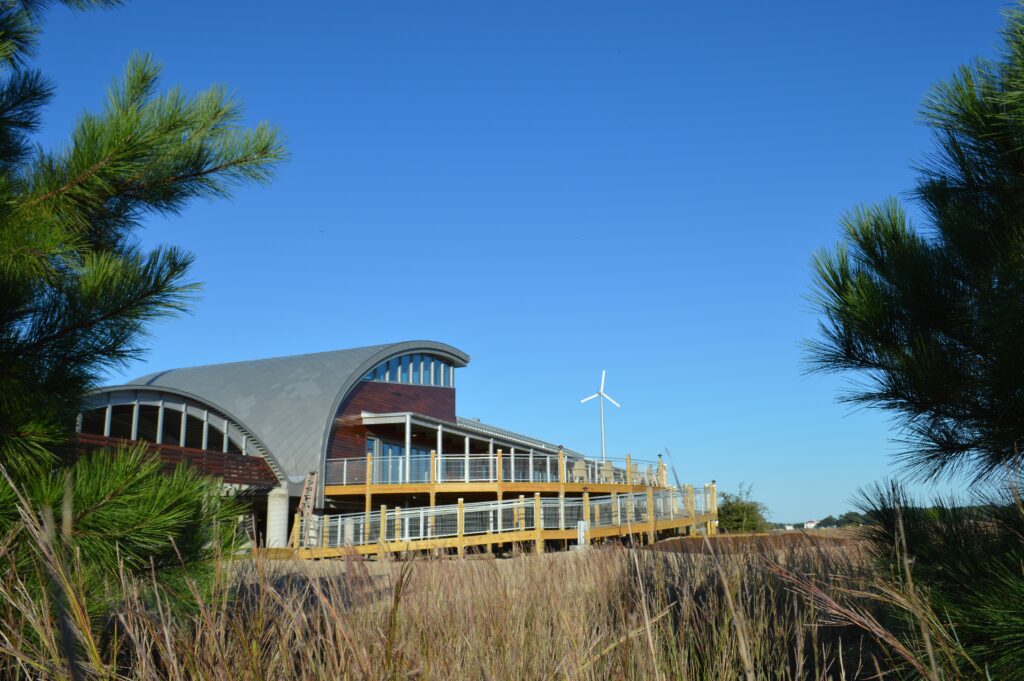On Feb. 24, 2021, the Hampton Roads Association for Commercial Real Estate (HRACRE) hosted a virtual event on Virginia’s burgeoning offshore wind future, spearheaded by Dominion Power’s $300 million pilot project consisting of two turbines 27 miles off the coast of Virginia Beach. Reliability testing last year confirmed the turbines’ 12-megawatts of power, which will ostensibly provide energy for an estimated 3,000 homes. Virginia Business reported it will include up to 190 turbines capable of powering 650,000 homes over the next five years. By 2040, more than 200,000 individuals are expected to move to the Hampton Roads region, which the Urban Land Institute called the fastest growing destinations for Millennials.

Sustainable growth, says HRACRE’s 2021 President Eric Keplinger, AIA, must be a coordinated effort for a region defined by 10 cities and nine counties that straddle two states. Keplinger, the 2018 President of AIA Virginia, sees offshore renewable energy as a critical opportunity for the region and for architects. “Working effectively across those boundaries is hugely important, and architects are positioned well to broker those conversations. They’re well positioned to think regionally and work locally,” he says.
Keplinger, whose Chesapeake-based firm MEB counts $400 million in coastal resilience projects as part of its portfolio, also says that while the economic development opportunities for the region are obvious, sustainable growth is a hand-in-glove imperative. “This is just the beginning of what will be years and years of resiliency work for this region and we are doing the test projects now that will develop best practices,” he says. “I see architects playing a unique role in this creative problem-solving process.”
Environmental conservation groups in the Hampton Roads area see the turbines as a positive step toward clean energy, but they say it must be taken in concert with steps to think systematically about air quality, soil erosion, and waterway health. Securing cleaner energy production is one side of the coin. Mitigating the impact of climate change is the other.
“In coastal Virginia, we have a lot of challenges contributing to sea level rise,” says Christy Everett, Hampton Roads Director of Chesapeake Bay Foundation. “What’s more, the land is sinking due to a number of factors, including groundwater withdrawal, land settling, and post-glacial land adjustments. Circulation pattern changes driven by warming water threatens us here in the Mid-Atlantic with more extreme weather. And, as the ocean warms, water expands. As ice melts, more water is created.”
Flood damage in Virginia Beach alone topped $155 million this year and an estimated 30,000 properties are at risk for flooding, according to Flood Factor, a watchdog dashboard created by the First Street Foundation. Architects working in coastal areas continue to develop strategies to help residential, commercial, and institutional clients identify and deal with the present and future threats of flooding. Working with nature, rather than defending against it, has become not only a best practice for some architects, but the only way forward.
In 2013, Chesapeake Bay Foundation opened the Brock Environmental Center a few hundred feet from the shoreline of the Lynnhaven River, in the heart of a flood zone that poses the highest risk to buildings in the area. Designed by SmithGroupJJR, the center received a 2017 AIA COTE Top 10 Plus award, is certified by the Living Building Challenge, and is certified LEED Platinum by the US Green Building Council. The building’s green credentials are daunting. It’s net-zero water and it was arguably the first in the nation to receive a commercial permit for offering treated rainwater to its visitors, greywater that hits the roof goes to rain gardens, and rainwater that hits the permeable pavers goes to bioswales. The building is net-positive energy, too, producing 80 percent more than it consumes in the span of a year. In fulfilling its public education mission, It’s other proof points are publicly available in a dashboard showing daily energy use, energy production, rainwater harvesting, and other systems meant to lessen its impact on the environment.
“When we built the Brock Environmental Center, we created green infrastructure on site to absorb stormwater and flood waters and we’ve had so many people come here to learn so we know the interest is out there.” says Everett. “There needs to be education, there need to be protective legislation, and there need to be financial incentives. But, there also have to be success stories in terms of greener models like Brock.”
Virginia Beach’s coastal resilience is tied to its energy future as much as it’s tied to the consequences of climate change. Last June, the Virginia Beach City Council approved a plan to adapt to rising sea levels, capping a six year, $3.8 million study. Called Sea Level Wise, the plan recommends billions of dollars of infrastructure improvements, property reclamation, and development restrictions. Last July, Governor Ralph Northam announced the Clean Energy Virginia initiative to secure the entirety of the state’s electricity from carbon-free sources by 2045, on the heels of the February’s Virginia Clean Economy Act.
For architects in the region, this is a time of adaptation to new regulations and new guidelines that are progressive and aggressive about climate action.
“Are there ways you can deal with the water, architecturally?” says Keplinger. “If we reach flood levels every 10 years that once we only reached every 100 years, then I think the importance of that question is evident.”
About the author
William Richards is a writer and editorial consultant based in Washington, D.C. From 2007 to 2011, he was the Editor-in-Chief of Inform Magazine.
